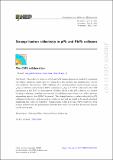Strange hadron collectivity in pPb and PbPb collisions
Author(s)
Tumasyan, A.; Adam, W.; Andrejkovic, J. W.; Bergauer, T.; Chatterjee, S.; Dragicevic, M.; Escalante Del Valle, A.; Frühwirth, R.; Jeitler, M.; Krammer, N.; Lechner, L.; Liko, D.; Mikulec, I.; Paulitsch, P.; Pitters, F. M.; Schieck, J.; Schöfbeck, R.; Schwarz, D.; ... Show more Show less
Download13130_2023_Article_20758.pdf (1.238Mb)
Publisher with Creative Commons License
Publisher with Creative Commons License
Creative Commons Attribution
Terms of use
Metadata
Show full item recordAbstract
Abstract
The collective behavior of
K
S
0
$$ {\textrm{K}}_{\textrm{S}}^0 $$
and
Λ
/
Λ
¯
$$ \Lambda /\overline{\Lambda} $$
strange hadrons is studied by measuring the elliptic azimuthal anisotropy (v2) using the scalar-product and multiparticle correlation methods. Proton-lead (pPb) collisions at a nucleon-nucleon center-of-mass energy
s
NN
$$ \sqrt{s_{\textrm{NN}}} $$
= 8.16 TeV and lead-lead (PbPb) collisions at
s
NN
$$ \sqrt{s_{\textrm{NN}}} $$
= 5.02 TeV collected by the CMS experiment at the LHC are investigated. Nonflow effects in the pPb collisions are studied by using a subevent cumulant analysis and by excluding events where a jet with transverse momentum greater than 20 GeV is present. The strange hadron v2 values extracted in pPb collisions via the four- and six-particle correlation method are found to be nearly identical, suggesting the collective behavior. Comparisons of the pPb and PbPb results for both strange hadrons and charged particles illustrate how event-by-event flow fluctuations depend on the system size.
Date issued
2023-05-02Department
Massachusetts Institute of Technology. Department of PhysicsPublisher
Springer Berlin Heidelberg
Citation
Journal of High Energy Physics. 2023 May 02;2023(5):7
Version: Final published version